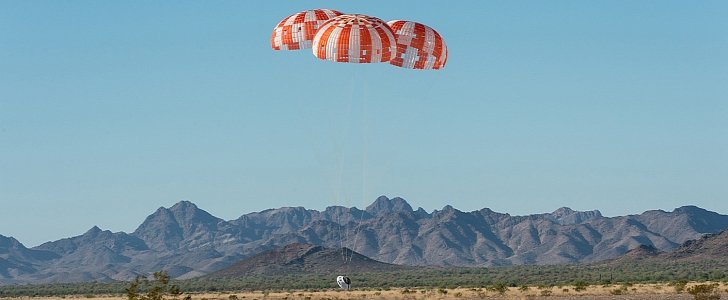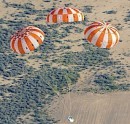As planned, the American space agency conducted the final test of the parachute system fitted onto the Orion capsule on Wednesday, proving that the concept works.
This last test was conducted at the U.S. Army’s Yuma Proving Ground in Arizona and required the Orion to be carried to an altitude of six and a half miles by a C-17 transport aircraft. From there, the capsule was dropped to test the 11 parachutes that make up the system.
Although most of the people on site for the test saw mainly the three main parachutes as they deployed, the system as a whole is much more complex. Aside for the parachutes themselves, it comprises cannon-like mortars, pyrotechnic bolt cutters, more than 30 miles of Kevlar lines and 36,000 square feet of parachute canopy material.
And it all had to work in a carefully choreographed sequence so that it would allow the crew in the capsule to slow from 300 mph (480 km/h) to only 32 mph before splashing into the Ocean.
In Wednesday’s test, all worked just as planned, opening the road for the next stage in the preparation of the capsule. The protective ring covering the system on top of Orion was jettisoned and pulled away by the first set of parachutes, only to be followed in precise sequence by all the rest.
After all tests are done, the Orion will be capable of carrying a crew of four astronauts to destinations at or beyond low Earth orbit. The first manned mission, called Exploration Mission-2, will take the four astronauts at thousands of miles beyond the Moon – NASA says this will be the farthest distance from Earth for any human - on the first true test for the ship.
““We’re working incredibly hard not only to make sure Orion’s ready to take our astronauts farther than we’ve been before, but to make sure they come home safely,” said Orion Program Manager Mark Kirasich.
“The parachute system is complex, and evaluating the parachutes repeatedly through our test series gives us confidence that we’ll be ready for any kind of landing day situation.”
The launch of Exploration Mission-2 is scheduled for 2023.
Although most of the people on site for the test saw mainly the three main parachutes as they deployed, the system as a whole is much more complex. Aside for the parachutes themselves, it comprises cannon-like mortars, pyrotechnic bolt cutters, more than 30 miles of Kevlar lines and 36,000 square feet of parachute canopy material.
And it all had to work in a carefully choreographed sequence so that it would allow the crew in the capsule to slow from 300 mph (480 km/h) to only 32 mph before splashing into the Ocean.
In Wednesday’s test, all worked just as planned, opening the road for the next stage in the preparation of the capsule. The protective ring covering the system on top of Orion was jettisoned and pulled away by the first set of parachutes, only to be followed in precise sequence by all the rest.
After all tests are done, the Orion will be capable of carrying a crew of four astronauts to destinations at or beyond low Earth orbit. The first manned mission, called Exploration Mission-2, will take the four astronauts at thousands of miles beyond the Moon – NASA says this will be the farthest distance from Earth for any human - on the first true test for the ship.
““We’re working incredibly hard not only to make sure Orion’s ready to take our astronauts farther than we’ve been before, but to make sure they come home safely,” said Orion Program Manager Mark Kirasich.
“The parachute system is complex, and evaluating the parachutes repeatedly through our test series gives us confidence that we’ll be ready for any kind of landing day situation.”
The launch of Exploration Mission-2 is scheduled for 2023.




